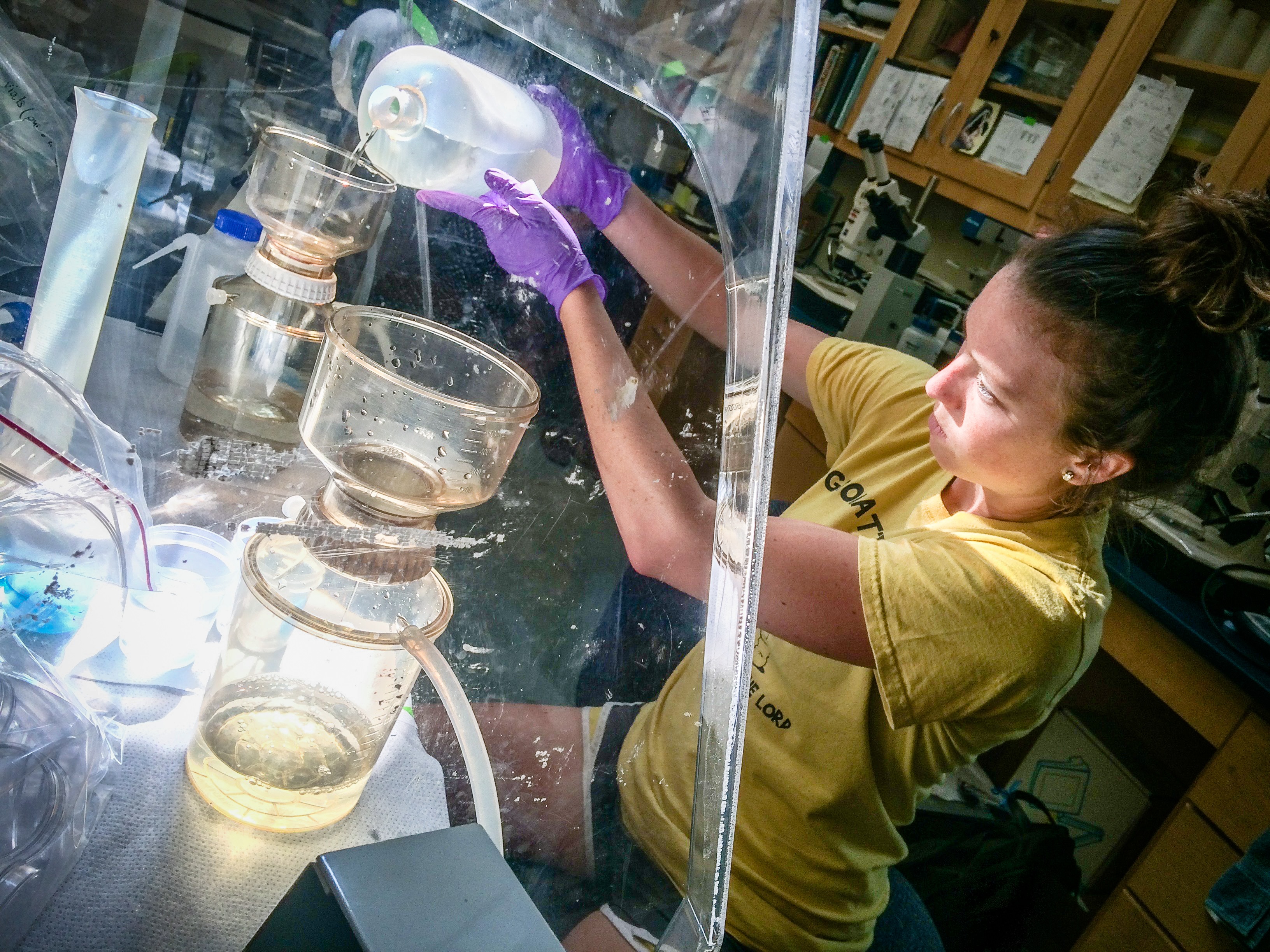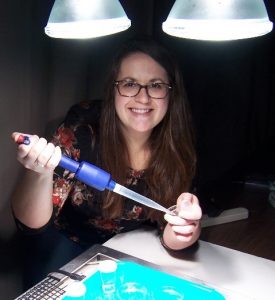Emily Seelen, a graduate student with Robert Mason who has a NSF Graduate Fellowship, was recently awarded a GROW (Graduate Research Opportunities Worldwide) fellowship to spend nine months working with Dr. Erik Björn at the University of Umeå in Sweden. Emily left in October to begin her study: “A molecular approach to understanding the bioavailability of methylmercury associated with various sources of natural dissolved organic matter (DOM)”. The focus is on coastal and oceanic DOM interaction with methylmercury, which has been studied very little relative to its interaction with other DOM pools. Emily’s research will involve the use of high resolution instrumentation to characterize the DOM and it’s methylmercury binding capacity including x-ray near edge adsorption structure spectroscopy, Orbitrap LC-MS, and other related approaches. Emily has been a NSF Graduate Fellow since July 2013.
Image: Emily extracting organic matter from water samples for her studies in Sweden.

Uncategorized
NOAA announces funding for research on sand lance
The Ocean & Atmospheric Research program (OAR) of NOAA and Sea Grant just announced the winners of its most recent round of research funding to better understand the consequences of ocean warming and acidification on key marine resources in U.S. Northeast coastal waters. Hannes Baumann and collaborators were happy and proud to learn that their proposed work on the climate sensitivity of Northern sand lance (Ammodytes dubius) was one of the four projects selected for funding. This is particularly good news for Chris Murray, who for his PhD can now expand his experimental rearing expertise to this important species.
This project will be conducted collaboratively with colleagues from NOAA (David Wiley), USGS (Page Valentine), Boston University (Les Kaufman), and Woods Hole Oceanographic Institution (Scott Gallager).
You can read the official announcement as it appeared on 6 September 2016 on NOAA’s News site
DMS graduate student Vena Haynes awarded EPA STAR Fellowship
Vena Haynes was recently awarded the EPA STAR Fellowship for her environmental toxicology research with Dr. J. Evan Ward. Vena is a PhD student in the UConn Marine Sciences program, where her research is focused on the effects of environmental pollutants on marine food webs. Manufactured nanomaterials are entering aquatic environments from product usage, industrial waste, and wastewater treatment plant effluents. Specifically, titanium dioxide nanoparticles found in consumer products, such as sunscreen and personal care products, can be toxic to organisms and its toxicity can increase with exposure to light. Very little research has been done on the effects of these nanoparticles in the marine environment with exposure to natural light. The objective of this project is to examine the effects of titanium dioxide nanoparticles on ecologically important food web grazers that inhabit coastal waters, using environmentally relevant experimental conditions. This work will aid in the development of safer nanomaterials and help predict impacts on grazer populations and organisms that rely on grazers for food (primarily fish).
Marine Sciences Alumni Chris Perkins captures stunning images of great whites!
The smile that says ‘I’d like to eat you!’ Photographer captures terrifying close-up of great white shark’s teeth as he comes face-to-face with deadly predator.
There can be few more terrifying sights in the world than a shark grinning greedily at you.
But American marine biologist Chris Perkins has captured the underwater predator in all its glory in a series of stunning images.
The stillness of the water gives an eerie insight into the stealth these apex predators use when breaching the ocean waves in search of their next meal.
Read more here!
Dimethylmercury in the Ocean: Where does it come from?
The accumulation of mercury, primarily as methylmercury, into fish and seafood consumed by humans is a global health concern. Recent research has highlighted the potential sources of methylmercury in the ocean, and demonstrated that it can be formed by microbial methylation of inorganic mercury. However, one of its sources could also be the degradation of dimethylmercury. There has been little study, however, of the formation pathways of dimethylmercury in the ocean, even though it has been detected in surface and deep waters.
A new paper published in Nature Scientific Reports (http://www.nature.com/articles/srep27958) by researchers in the Department of Marine Sciences (DMS) at the University of Connecticut has shed light on potential pathways for its formation, and suggests that dimethylmercury may be formed by abiotic processes from methylmercury. These studies were carried out by research scientist Sofi Jonsson and graduate student Nashaat Mazrui in Robert Mason’s laboratory. Their experiments show that dimethylmercury can be formed in the presence of iron sulfide particles, as well as other metal sulfide particles, via the reaction of two methylmercury molecules bound to the particle surface. The products of the reaction are dimethylmercury and inorganic mercury, which is precipitated onto the surface. In addition, these reactions were also shown to occur in the presence of organic compounds with reduced sulfur groups (thiols). The proximity of the bound methylmercury molecules determines the rate of the reaction, and the reaction is more favorable with organic compounds with multiple thiols.
“The reaction pathways are highly favorable and we were able to show that the reactions occur under a wide variety of conditions” said Jonsson “and our calculations suggest that these mechanisms could account for much of the dimethylmercury in the ocean.” Mason commented that recent estimates suggest that about half the methylmercury formed in the upper ocean is from the degradation of dimethylmercury, and that further studies are needed to examine the importance of the proposed pathway compared to other mechanisms. The authors suggest that such reactions could be occurring within particles in the ocean, or within microbial cells. It is also possible that the reactions could occur on the surface of nanoparticles and Mason’s group, in collaboration with Jing Zhao at the Department of Chemistry (UConn), will further explore this possibility by studying these reactions on both natural and manufactured nanoparticles, and the factors that influence the reaction rate.
Early measurements of dimethylmercury in the equatorial Pacific Ocean were made by Jon Kim and Robert Mason, while graduate students at DMS, and many other studies have reported its presence in ocean waters since then. One place where dimethylmercury has been measured in higher concentrations is the Arctic and a recent modeling paper by researchers at Harvard suggests that a large fraction of the methylmercury produced in the Arctic is converted to dimethylmercury. Although the paper published from researchers at Harvard does not propose a mechanism for this reaction, it could involve the reactions proposed on particle surfaces in the water or sediment. Jonsson will later this summer participate in a research expedition in the Arctic onboard the Swedish icebreaker Oden which will allow her to test some of the ideas about formation and stability of dimethylmercury in this region.
Airborne Campaign to Map Coral Reef Ecology is Underway
Dr. Dierssen, professor in Marine Sciences, is participating in a new NASA-funded project to conduct airborne mapping of coral reef ecology as part of the COral Reef Airborne Laboratory (CORAL). Her team will collect field data to validate the remote sensing observations collected in Hawaii, the Mariana Islands, Palau, and the Great Barrier Reef. For each reef, the spectral imagery will be processed to assess the distribution of coral and rates of coral primary productivity and calcification. A recent Nature article describes the project: http://www.nature.com/news/marine-ecologists-take-to-the-skies-to-study-coral-reefs-1.20004
Melissa Pierce received the Thurlow C. Nelson Award for Outstanding Student Oral Presentation
Doctoral candidate Melissa Pierce received the Thurlow C. Nelson Award for Outstanding Student Oral Presentation from the National Shellfisheries Association. Melissa received the award for her talk entitled “Bivalves maintain a core gut microbiome: seasonal trends and species variation,” at the Aquaculture 2016 meeting. The Thurlow C. Nelson Award is given for an outstanding oral presentation of research that represents a distinctive and valuable contribution to shellfisheries science. The Award is named after the distinguished shellfish biologist who served as NSA President from 1931-1933 and contributed more than 125 papers, many relating to oyster biology.
20th Anniversary of Feng Graduate Research Colloquium
The 11th Biennial Feng Graduate Research Colloquium on May 12, 2016, is also the 20th anniversary of this event, which showcases and celebrates the research projects of graduate students in the Department of Marine Sciences.
The all-day event will feature talks and posters. Download the program and presentation abstracts below.
Short Program
Long Program (includes abstracts)
Graduating doctoral students Melissa Pierce and Maria Rosa hired for post-doctoral positions
Congratulations to Melissa Pierce for being hired as a post-doctoral research associate at The University of Illinois at Chicago. Melissa will be working in the laboratory of Dr. Rachel Poretsky on a NOAA-funded project. The project is aimed at improving aquaculture conditions for sablefish by evaluating the influence of the microbial community, DMSP, and potential algal/bacterial interactions on larval growth and behavior. Sablefish (also known as black cod) are a species of interest to the aquaculture community in part because of their high omega-3 fatty acid content.
Congratulations to Maria Rosa on her recently awarded NSF Post-doctoral Fellowship in Biology! Maria will be conducting her post-doc at Stony Brook University with sponsoring scientist Dr. Dianna K. Padilla. The goal of the study is to determine the relative importance of different feeding modes during early ontogenetic stages of representative species of suspension-feeding molluscs.
Monahan to Receive Distinguished Service Award from CASE
Rocky Hill, CT – The Connecticut Academy of Science and Engineering (CASE) will present a CASE award for Distinguished Service to its member Edward C. Monahan for his outstanding leadership within the Academy, specifically for significant contributions through his 12 years of service as the CASE Bulletin Executive Editor for Science. The CASE Governing Council created the Distinguished Service Award in 2010 to honor members who have provided outstanding service to the Academy. CASE will present the award at its 41st Annual Meeting and Dinner on Tuesday, May 24th at the University of New Haven.
Monahan was elected to CASE in 1999 and has served as Executive Editor for Science of the quarterly CASE Bulletin from 2004 to 2016. He is the longest serving Executive Editor in the history of the publication, having exceeded the previous record of 10 years. He retires from this role effective this spring. During his service, he provided expert scientific and technical advice, assisted in the selection of the feature articles, and reviewed each issue for quality and to ensure that information of interest to the Bulletin readership was included and understandable to individuals with a wide range of backgrounds. In this role, Professor Monahan also regularly participated in quarterly meetings of the Academy’s Governing Council. He has also served as a study committee member on the CASE – Long Island Sound Symposium: A Study of Benthic Habitats (2004).
Ed received a PhD from MIT, a DSc from the National University of Ireland, and is a Fellow of both the American Meteorological Society and the Acoustical Society of America. His research activities continue to center on investigations of those physical processes involved in air-sea exchange. He has greatly enhanced the understanding of the role of bubbles in mediating the air-sea exchange of sea-salt, moisture, heat, and gases, and while doing so has pointed out the significance of these air-sea interactions in the maintenance of the climate on earth.
For 20 years, he was the Director of the Connecticut Sea Grant Program at the University of Connecticut, Avery Point, and in retirement, currently serves as the Chairman of the Southeastern Connecticut Water Authority.
###
The Connecticut Academy of Science and Engineering was chartered by the General Assembly in 1976 to provide expert guidance on science and technology to the people and to the state of Connecticut, and to promote the application of science and technology to human welfare and economic well being. For more information about the Academy, visit www.ctcase.org.


